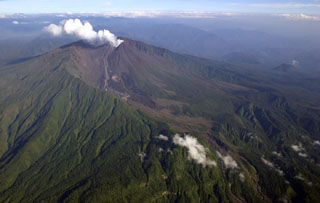Report on Reventador (Ecuador) — 4 December-10 December 2019
Smithsonian Institution / US Geological Survey
Weekly Volcanic Activity Report, 4 December-10 December 2019
Managing Editor: Sally Sennert.
Please cite this report as:
Global Volcanism Program, 2019. Report on Reventador (Ecuador) (Sennert, S, ed.). Weekly Volcanic Activity Report, 4 December-10 December 2019. Smithsonian Institution and US Geological Survey.
Reventador
Ecuador
0.077°S, 77.656°W; summit elev. 3562 m
All times are local (unless otherwise noted)
IG reported that during 4-10 December seismic data from Reventador’s network indicated a high level of seismic activity, including explosions, long-period earthquakes, harmonic tremor, and signals indicating emissions. Weather sometimes prevented views of the summit area, although during clear conditions ash, gas, and steam plumes were visible rising sometimes higher than 1 km above the crater rim and drifting N, NW, W, and SW. Crater incandescence was periodically observed at night. Blocks rolled 500-700 m down the flanks in multiple directions during 7-10 December.
Geological Summary. Volcán El Reventador is the most frequently active of a chain of Ecuadorian volcanoes in the Cordillera Real, well east of the principal volcanic axis. The forested, dominantly andesitic stratovolcano has 4-km-wide avalanche scarp open to the E formed by edifice collapse. A young, unvegetated, cone rises from the amphitheater floor to a height comparable to the rim. It has been the source of numerous lava flows as well as explosive eruptions visible from Quito, about 90 km ESE. Frequent lahars in this region of heavy rainfall have left extensive deposits on the scarp slope. The largest recorded eruption took place in 2002, producing a 17-km-high eruption column, pyroclastic flows that traveled up to 8 km, and lava flows from summit and flank vents.
Source: Instituto Geofísico-Escuela Politécnica Nacional (IG-EPN)

